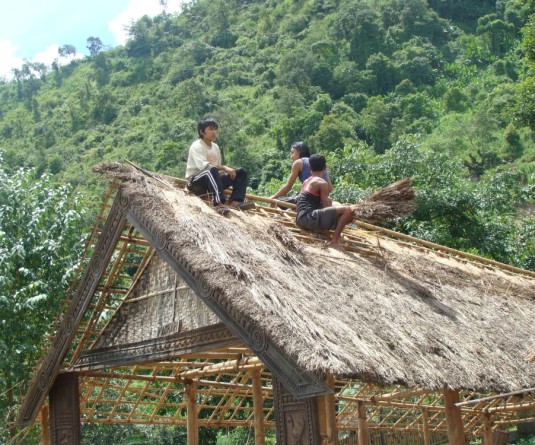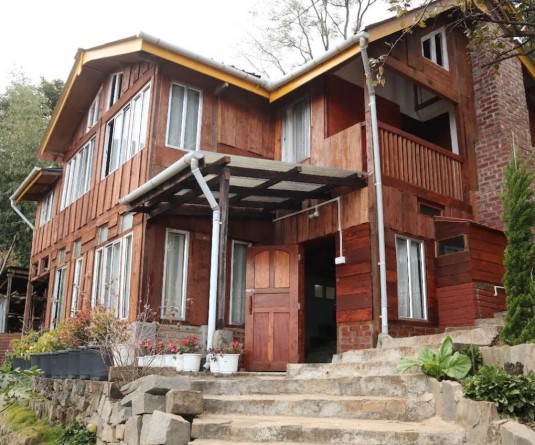A Naga boy walks home with drinking water collected from a nearby stream, May 31, about 15 Kms towards Kohima. (Sorei Mahong/Photo)
Al Ngullie
Morung Express News
Dimapur | June 1
Mounting Per Capita Income and rising literacy rates, pushed by infrastructural ambitions of the Government of Nagaland for the state’s chief commercial district – Dimapur – remains confined to urban aspirations. In 2004, Nagaland’s first Human Development report listed Dimapur district’s Human Development Index at 0.73 – the highest of the then 8 districts. The aggregate, however, was not comprehensible on points that indicate the extent of underlying poverty, increased rural-unemployed persons and economic tensions in the rural areas of the district.
Of the roughly 3, 08,382 (2001) estimated population, the financial district is also home to the largest concentration of the rural “lower-working-class” in Nagaland – an estimated 1, 84, 490 (2001, NEDFi) while only a comparatively smaller 1, 28, 392 were concentrated in the urban areas. But the challenge posed to poverty-alleviation strategies is mainly the BPL sections: So far the department of Food and Civil Supplies has identified 11,838 BPL families in Dimapur district.
Unavailability of official data or statistical banks on the number or status of rural poverty or unemployed subject-matter in Dimapur is a currently unassailable hindrance to making feasible assessments on the human development aspects of Dimapur’s rural poor.
Nonetheless, Nagaland’s Human Development report of 2004 offers an insight into the district’s rural employed: the percentage of persons in the unskilled labor, unorganized, agricultural sector is 60, 260. Under the figure are listed cultivators (47.55%) and the rest, agriculture laborers and “other workers.”
This “lower-working-class” section is, in all technical terms, generally citizens who skirt the fringes of Below Poverty Line (BPL) and constitute the cheap-labor force for Dimapur’s local economy. Lifting Dimapur’s rural poor out of the economic mire remains a colossal challenge for the State – the mixed results from the state government’s developmental schemes in the district for the past two fiscal years don’t point to much progress for the district’s rural sections.
Currently, the Nagaland government is implementing 3 centrally-sponsored rural schemes under the Dimapur District Rural Development Agency to bolster development of Dimapur’s rural section. The principal rural-targeted schemes are the poverty-alleviation incentive Swarnjayanti Gram Swarozgar Yojana (SGSY), the rural housing scheme Indira Awas Yojana (IAY) and the guaranteed rural-employment program the National Rural Employment Guarantee Scheme (NREGS). There are also other targeted schemes from the Nagaland government as well but are chiefly concerned with finance-mobilization and rural resource management to act as supplements to the Centre’s schemes.
NREGS for Dimapur
The National Rural Employment Guarantee Scheme (NREGS) is Dimapur’s most visible anti-rural unemployment strategy of the Nagaland government. For Dimapur the NREGA targets alleviating rural unemployment in the district’s four administrative blocks: Dhansiripahar, Medziphema, Kuhuboto and Niuland. 216 villages are estimated under the four subdivisions.
It is observed that the chief reasons the NREGA has become crucial for Dimapur are the fact that the state’s government has (i) no other means that offer direct employment to the district’s burgeoning rural population (ii) no check-mechanism to curb the huge floating/migrating population (from Nagaland’s other rural areas and other states) adding to Dimapur’s already-straining economic situation (iii) no resources to devise economic strategies/mechanisms to reconcile economic disparities with development policies to uplift the rural poor.
In Dimapur, NREGS-implementation is comparatively better – although by a small extent – than most districts’. At the time of filing this News report, Nagaland’s political Opposition, the Congress party had been up in arms against the Naga People’s Front-led Democratic Alliance of Nagaland government over allegations of widespread corruption and mismanagement in the implementation of the NREGS. It is found that employment under NREGS has been provided to 408 Lakh households with rural women accounting for 49.98%. Rs. 42.45 Crore was the total fund for Dimapur for 800 works taken up, 468 completed and 332 still in progress.
After Nagaland captured headlines being found deficient in the implementation of the scheme in the earlier years, intensified scrutiny from opposition political parties and watchdog Media attention in Nagaland have resulted in a level of apparent accountability. In Dimapur, the number of persons from the rural populations provided with employment under NREGA shows that during year 2008-2009 till May 2010, NREGS provided employment to 35, 264 households (45, 348 persons) in Dimapur. (The rural families were all from Dhansiriphar, Medziphema and Kuhuboto and Niuland subdivisions with an average of about 40 villages spread between them). However, for 2009-2010 till May 2010 (starting fiscal year) the number is expected to be even higher: households provided with employment were being counted at 20, 181 (21112 persons) even as the fiscal year was just about starting.
The employment provided for NREGS is only a small supplement, but nevertheless a respite for Dimapur’s rural, agriculture-farming poor (The Morung Express April 19, 2010 Edition, front page).
Many still believe that greater reliance would be on agricultural activities and “Hajira” or one-day’s work-wage (The Morung Express May 28, 2010 Edition, front page) but NREGA is a boon for the BPL citizen who is even too malnourished to tackle day-wage contracts. “When the rains failed last year (2008) we had no harvest and had to look for day’s wage. My family has a Job Card (NREGA) and the about 40-day employment helped me greatly,” said Puntovi Assumi (name changed) a Sumi Naga villager in Dimapur. But, he added wryly, “I still want a permanent job; Hajira is very difficult and cannot make ends meet; I am not complaining but I want to make some worthwhile earnings; NREGA is only a small help,” the 24 year old school-dropout confided in chaste “Nagamese”, a local Creole.
The Indira Awas Yojna
On September 15, 2009 Nagaland was conferred the Bharat Nirman Award for Rural Housing from The India Today Group for effective implementation of Indira Awaas Yojna (IAY) during the 7th India Today Chief Ministers’ Conclave in New Delhi. Rural Housing is evidently the most successful rural scheme in Nagaland targeting the rural sections. Or at least the Bharat Nirman Award pointed to.
The IAY is one of the most ‘heard-about’ in the state as is in Dimapur district. The Nagaland government is pushing the IAY offering rural housing models based on local living requirements and local-low cost technology. A special aspect of the IAY for Nagaland is the consideration given to the localized but diverse tribal, social, traditional and local requirements. Under IAY, citizens in Dimapur’s rural areas are provided tin roofing sheets; houses are constructed with the inherent traditional practice of the community contributing free labor and materials such timber and split bamboo matting.
IAY in Nagaland is considered by many to be the one “100%” success scheme and its echoes can be seen in many a villager’s story. During receiving the Bharat Nirman Award, Nagaland’s Parliamentary Secretary for Rural Development Pangnyu Phom said that, through the IAY 100 percent housing coverage in many villages have been achieved. The poorest of the poor citizens are being given “an identity” in the dignity of owning an own house. Updated data on IAY coverage for Dimapur district could not be obtained despite attempts. Villagers from various villages in Dimapur said they receive CGI sheets in an annum through Village Development Boards or Village Councils.
There are also a few constraints though. For instance the about 200 established villages in Dimapur are mostly without proper communication network or roads. Inaccessibility has also led to some villagers not receiving their quota. “I heard that tin sheets would be given to us but I still live in a thatch house,” a villager from a Western Sumi village told this reporter. And there are others who are not sure if the NREGA or IAY are actually in implementation. “Yes, we have received some tin sheets about a year ago” and “adha-puoa” (about half-a kilogram) of rice the previous year,” Heka, a villager from the Dhansiripahar fringe said.
The SGSY
Other poverty-targeted schemes such as the Swarnjayanti Gram Swarozgar Yojana (SGSY) are being implemented in Dimapur supplemented by state-sponsored Grant-in-Aid to BPL families. SGSY is one of the state’s main anti-poverty schemes for the rural poor using capacity-building strategies to bring the rural sections into productive economic livelihood. In the fiscal year 2008-2009, the government has been undertaking capacity-development programmes to assist rural farmers and rural poor receive financial backing from institutions. Sources point out that the SGSY is one of the successful schemes in Dimapur district.
One common refrain being heard from banking institutions is their reluctance to extend loans to those from the rural areas. The reason is that villagers, who are mostly farming day-wage earners, are unable to repay loans. They arrears that amass cost the banks’ investment. Those unable to repay the loans are then ‘blacklisted.’ Basically, the most normal thing to do for the rural man is to ‘just forget it.’ The lament of a non-Naga farmer from Dhansiripahar sub-division, “Bikash”: “I am paid Rs. 80 for one-day work. So if the day’s wages are at least Rs. 75 I can make around Rs. 2100. But I cannot pay Rs. 800 or Rs. 1000 every month for a Rs. 70, 000 loan which I take to roof my house. What will my family and children eat if I pay the loan?” He adds: “I can only hope rains don’t delay that I can finish tilling in one filed and still have time to work for extra on another.”
By and large, as far as the targeted-intervention against poverty is concerned, schemes such as the NREGS, IAY or SGSY have been fruitful for the rural poor in Dimapur. While political dynamics have contributed too, factors of social intervention have been much responsible in pushing forward the programmes in Dimapur to a substantial extent.
Nagaland is famous for its self-devised system of ‘Communitization’ – ‘that owned by the community.’ Village councils and village development boards (VDBs) empowered by the Communitization of Public Institutions and Services Act, 2002, have been extremely active in Dimapur. Their focus has been agriculture education, health and the rural power sector. The success of communitization is an acknowledged fact.
With the village and local authorities delegated with powers of implementation and agency by the Nagaland government, rural-uplift strategies and implementation have been fairly – generally – commendable in Dimapur district.
This News report was filed in aegis of the Inclusive Media Fellowship for Journalists 2010, awarded to this Reporter by the Center for the Study of Development Societies CSDS), New Delhi under Inclusive Media Project.






